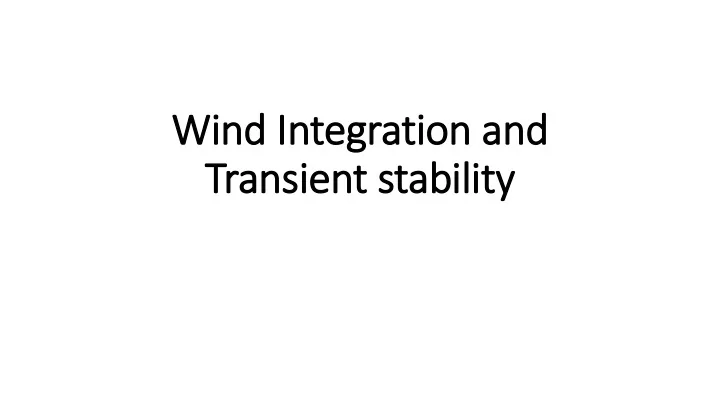

Wind In Integration and Transient stability
Types of f Win ind Generators Figure 1: Direct-in-line wind turbine system. [1]
Types of f Win ind Generators Figure 2: Doubly fed induction generator wind turbine system. [2]
Modelling of f DFIG Figure 4: Equivalent circuit of DFIG [3] Figure 3: Conventional induction machine equivalent circuit [3]
In Inducti tion Machine-Torque Slip lip Characteristic ics • For low value Slip, Torque is directly proportional to slip. STABLE REGION of OPERATION • For high value of Slip, Torque is inversely proportional to slip. UNSTABLE REGION of OPERATION
Controlling DFI FIG Figure 7: Torque Slip characteristics of DFIG with Figure 6: Torque Slip characteristics of DFIG with Constant Vq and varying Vd [3] Constant Vd and varying Vq [3]
Controlling DFIG-Vector Control: Figure 8: Stator Real Power, Slip characteristics of Figure 9: Stator Real Power, Slip characteristics of DFIG with Constant Vq and varying Vd [3] DFIG with Constant Vd and varying Vq [3]
Controlling DFIG-Vector Control: Figure 10: Stator Reactive Power, Slip characteristics of Figure 9: Stator Reactive Power, Slip characteristics of DFIG with Constant Vd and varying Vq [3] DFIG with Constant Vq and varying Vd [3]
Controlling DFIG-Vector Control: Figure 11: Rotor Real Power, Slip characteristics of Figure 12: Rotor Real Power, Slip characteristics of DFIG with Constant Vd and varying Vq [3] DFIG with Constant Vq and varying Vd [3]
Controlling DFIG-Vector Control: Figure 12: Rotor Reactive Power, Slip characteristics of Figure 13: Rotor Reactive Power, Slip characteristics of DFIG with varying Vd and Vq = 0.2 pu [3] DFIG with varying Vd and Vq = 0.4 pu [3] • Therefore, proper coordination between both Vq and Vd components of the DFIG injected rotor voltage results in optimal operation of DFIG in terms of torque, real power and reactive power.
Effect of f ad addin ing wind with th an and with thout Transmis issio ion line on Transie ient St Stabili ility: IEEE 14 bus system at bus 1 Figure 14: Comparing transient stability effects on rotor angle and Vbus1 with three phase fault [4]
Effects of f Addin ing Wind ind th through Different In Interconnectio ion Voltages IEEE 14 bus system at bus 1 Figure 15: Comparing transient stability effects on rotor angle and Vbus1 with three phase fault [4]
Effects of f Addin ing Wind ind to Dif ifferent Bu Buses IEEE 14 bus system Figure 16: Comparing transient stability effects on rotor angle and Vbus1 with three phase fault [4]
Effects of f Addin ing Wind ind Th Through Multip ltiple le Transmis issio ion Lin Lines IEEE 14 bus system Figure 17: Comparing transient stability effects on rotor angle and Vbus1 with three phase fault [4]
Transient St Stabilit ity In Index: • Transient Stability Index (TSI) is defined to estimate system transient stability. • Analysis says that system is adversely affected when faults are near to areas with high wind penetration. • Small penetration of DFIG has positive impact on the system and high penetration has negative impact on transient stability • Fault Ride Through Capability • • where, δ max is the maximum angle separation of any two generators in the system at the same time in the post-fault response. TSI>0 and TSI ≤ 0 correspond to stable and unstable conditions respectively.
Role of f SVC and STATCOM Figure 19: STATCOM Figure 18: Static VAR Compensator
Role of f SVC and STATCOM Figure 21: Bus 5 voltage variation Figure 20: Oscillations in Power output of Generator 1 (IEEE 14 bus system) [5] (IEEE 14 bus system) [5]
Role of f STATCOM Test Case 2: Figure 22: 10-machine test system [6]
Role of f STATCOM Figure 24 : Rotor angles in case with STATCOM of 3 % of Figure 23: Rotor angles in case without STATCOM [6] total generation capacity. [6]
Role of f STATCOM Figure 24 : Rotor angles in case with STATCOM of 6 % of total generation capacity. [6]
Role of f STATCOM Table 1: Critical Clearing Time for Faults at different locations with Energy Storage as percentage of total generation [6]
Thank You
Recommend
More recommend